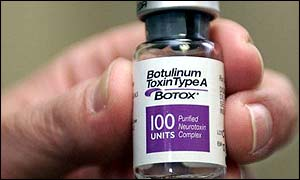Challenge: Botulinum Toxin’s Reputation, The Most Powerful Toxin, Gets a Facelift
Hi Steemit, now we talk about one of spectacular facts dangerous toxin.
The powerful toxin produced by Clostridium botulinum causes the deadly food poisoning botulism. Yet this dreaded, highly lethal poison has been put to use as a treatment for alleviating specifc movement disorders and, more recently, has been added to the list of tools that cosmetic surgeons use to fight wrinkles.

During the past several decades, botulinum toxin, marketed in therapeutic doses as Botox , has offered welcome relief to people with painful, disruptive neuromuscular diseases known categorically as dystonias . These conditions are characterized by spasms (excessive, sustained, involuntarily produced muscle contractions) that result in involuntary twisting or abnormal postures, depending on the body part affected. For example, painful neck spasms that twist the head to one side result from spasmodic torticollis (tortus means “twisted”; collum means “neck”), the most common dystonia. The problem is believed to arise from too little inhibitory input compared to excitatory input to the motor neurons that supply the affected muscle. The reasons for this imbalance in motor-neuron input are unknown. The end result of excessive motor-neuron activation is sustained, disabling contraction of the muscle supplied by the overactive motor neurons.
Fortunately, injecting minuscule amounts of botulinum toxin into the affected muscle causes a reversible, partial paralysis of the muscle. Botulinum toxin interferes with the release of muscle-contractioncausing ACh from the overactive motor neurons at the neuromuscular junctions in the treated muscle. The goal is to inject just enough botulinum toxin to alleviate the troublesome spasmodic contractions but not enough to eliminate the normal contractions needed for ordinary movements. The therapeutic dose is considerably less than the amount of toxin needed to induce even mild symptoms of botulinum poisoning. Botulinum toxin is eventually cleared away, so its musclerelaxing effects wear off after 3 to 6 months, at which time the treatment must be repeated.
The first dystonia for which Botox was approved as a treatment by the U.S. Food and Drug Administration (FDA) was blepharospasm (blepharo means “eyelid”). In this condition, sustained and involuntary contractions of the muscles around the eye nearly permanently close the eyelids. Botulinum toxin’s potential as a treatment option for cosmetic surgeons was accidentally discovered when physicians noted that injections used to counter abnormal eye muscle contractions also smoothed the appearance of wrinkles in the treated areas. It turns out that frown lines, crow’s feet, and furrowed brows are caused by facial muscles that have become overactivated, or permanently contracted, as a result of years of performing certain repetitive facial expressions. By relaxing these muscles, botulinum toxin emporarily smoothes out these age-related wrinkles. Botox now has FDA approval as an antiwrinkle treatment. The agent is considered an excellent alternative to facelift surgery for combating lines and creases. This treatment is among the most rapidly growing cosmetic procedures in the United States, especially in the entertainment industry and in high-fashion circles. However, as with its therapeutic use to treat dystonias, the costly injections of botulinum toxin must be repeated every 3 to 6 months to maintain the desired effect in appearance. Furthermore, Botox does not work against the fine, crinkly wrinkles associated with years of excessive sun exposure because these wrinkles are caused by skin damage, not by contracted muscles.
Source: Physiology Sherwood
https://www.consultingroom.com/Treatment/Botox
Thanks for vote @andesign, sering2 ya :D, baru buat soalnya hehe